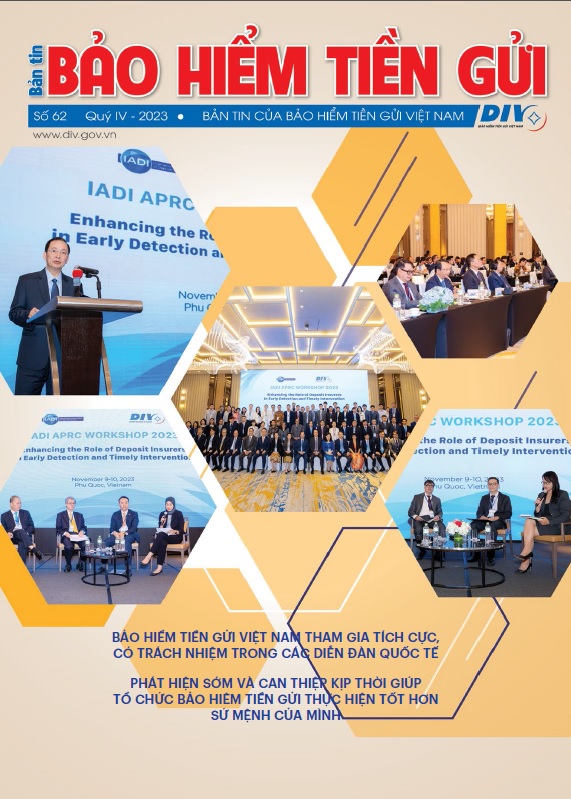Shortening payout period, timely protecting depositors
Effective reimbursement is the first and foremost factor in maintaining public confidence and contributing to the safety and soundness of the credit institutions system, especially in case of winding up a credit institution. Article 23 of the Law on Deposit Insurance states that, within 60 days since the payment duty arises, the deposit insurer is responsible for reimbursing insured depositors.
According to international best practices in reimbursement, in case of advanced deposit insurers, legal regulations stipulate a much shorter payout period than the 60-day duration. Deposit insurers usually set out a targeted payout period with the highest efforts. Accordingly, it takes 2 and 3 days for the Federal Deposit Insurance Corporation (USA) and the Central Deposit Insurance Corporation (Taiwan), respectively, to finish reimbursement after the bank closure. In Canada, the deposit insurer makes partial and full payment within 5 and 14 days, respectively, while in England, it is targeted to reimburse depositors within 7 days after the bank closure. The International Association of Deposit Insurers (IADI) recommends that it should be regulated that the target reimbursement is 7 days after the deposit-taking bank declares to close its operations (closure).
Given international best practices and reimbursement conditions in Vietnam, the regulated 60-day payout period should be shortened to mitigate adverse effects on depositors’ confidence and minimize bank runs that may be triggered due to bank closures.
Factors affecting the payout period include: the ability to access information on insured deposits, human resources, payout methods, and IT infrastructure. In case of the Deposit Insurance of Vietnam (DIV), all of the factors have been significantly upgraded. From June 2017 till now, insured institutions have provided the DIV with information on insured deposits on a periodic basis. The DIV’s current human resources are capable of conducting reimbursement. In addition, the Law on Deposit Insurance allows the deposit insurer to make reimbursement to depositors by itself or via another insured institution with its authorization. Thereby, the DIV may authorize other agencies when it is necessary to shorten the payout period. Furthermore, the Financial Sector Modernization and Information Management System Project (FSMIMS project), which was funded by the World Bank and granted to Vietnam, has been putting into use, contributing to improving the conditions of accessing information on deposits and facilitating bank resolution in case the payout period needs to be shortened.
Controlling moral hazard in deposit insurance operations
In addition to its good side, deposit insurance may trigger several risks. The comprehensive awareness of those risks and the availability of measures to closely prevent and control risks will enhance the efficiency of deposit insurance operations. Article 10 of the Law on deposit insurance stipulates prohibited acts in deposit insurance, but those triggering moral hazard are not mentioned yet.
Moral hazard in credit institutions’ operations, which is related to deposit insurance, is quite diversified. It should be identified and controlled. Depositors tend to pay little attention to credit institutions’ operations as they think those credit institutions are participating in deposit insurance, so no risk is exposed to their deposits. They usually feel relieved and seek credit institutions with high interest rates. As a result, credit institutions are more likely to accept higher risks. Moreover, if deposit-taking institutions get into trouble that may lead to being closed, they may take advantage of deposit insurance.
During its participation in special control of insured institutions (especially people’s credit funds), the DIV has detected some frauds of taking advantage of deposit insurance, such as: Customers and staff of insured institutions agree to split deposits that exceed the coverage limit into smaller ones of many people to receive higher payment; Rationalizing off-the-book deposits; Borrowing funds after the payment duty arises, etc. Meanwhile, in the Law on Deposit Insurance, there are no specific regulations in which those are prohibited acts, leading to the DIV’s inability to deal with those acts.
According to IADI’s guidance, profiteering of deposit insurance is an act that leads to or may lead to false reimbursement to uninsured depositors or overpayment. Profiteering of deposit insurance may include: Replacing deposit owners (replacing uninsured depositors with insured ones); Splitting deposits that exceed the regulated coverage limit and transferring uninsured portions of deposits to other people’s insured accounts; Recording false depositors or deposits into the list of insured deposits or excluding depositors’ liabilities during set-off; Recording false deposits into banks’ books for appropriation of the deposit insurance funds. Besides, fraud and profiteering of deposit insurance are stipulated in the Law on Deposit Insurance in some jurisdictions (Philippines, Taiwan, etc.).
It is necessary to consider supplementing the definition of profiteering of deposit insurance, exemption clause, and right to refuse to make reimbursement in case of profiteering of deposit insurance to establish an effective deposit insurance scheme and market discipline, minimize negative impacts of moral hazard. Splitting and transferring insured deposits for higher reimbursement should also be added to the list of prohibited acts.
Moving towards applying risk-based premiums
In the field of deposit insurance, there are two ways of calculating premiums: the flat rate method and the risk-based method. The IADI recommends that flat-rate premium should be put in place during the early establishment of deposit insurance organizations. With the development of deposit insurance operations, risk-based premium should be applied instead.
The Law on Deposit Insurance states: “The Prime Minister shall set the frame of deposit insurance premium under the proposal of the State Bank of Vietnam (SBV); Under the premium frame, the SBV shall determine specific premium rates for insured institutions on the basis of assessment and classification of those insured institutions.”
Over the past nearly 23 years since the DIV’s establishment, the annual flat rate of 0.15% per average insured deposit at an insured institution has been applied. This premium calculation method is suitable for the early stage of the deposit insurer and the transition economy (changing from the centrally planned to the Socialist-oriented market economy). However, in the long term, the flat-rate premium system will not create healthy competition among credit institutions or encourage insured institutions to improve their operational efficiency to have lower rates, contributing to the increase of moral hazard. Therefore, in order to be consistent with the current situation and international best practices, it is essential to have guidance on the premium calculation on the basis of the assessment and classification of insured institutions.
According to Clause 2 of Article 20 of the Law on Deposit Insurance, differential premium rates are based on the ranking results of insured institutions and foreign bank branches, which is conducted by the SBV. In fact, the assessment and classification of insured institutions by the SBV are for management purposes only and are not publicized. Therefore, it is necessary to amend the regulation on the authorization of assessment and classification of insured institutions. Specifically, the Law on Deposit Insurance should be amended and supplemented as follows: The Prime Minister shall set the frame of deposit insurance premiums under the proposal of the SBV; Under the premium frame, the SBV shall determine specific premium rates for insured institutions on the basis of the DIV’s assessment and classification of those insured institutions. The DIV is allowed to assess and categorize insured institutions on the basis of specific criteria and information obtained from the SBV to calculate risk-based premiums.
Protecting depositors is the ultimate goal of deposit insurance policies. Depositors are protected directly through the payout in case of bank failures and indirectly via the safe and sound development of the financial and banking system. In recent years, deposit insurance policies have contributed positively to the innovation and development of credit institutions system in Vietnam. In order to improve the enforcement of deposit insurance policies, it is crucial to upgrade the legal framework of deposit insurance. In addition, several aspects of the Law on Deposit Insurance lack details and updates compared to international best practices, such as shortening payout period, control of moral hazard, differential premium rates, etc., posing the need to be stipulated in the upcoming amended Law on Deposit Insurance.



























